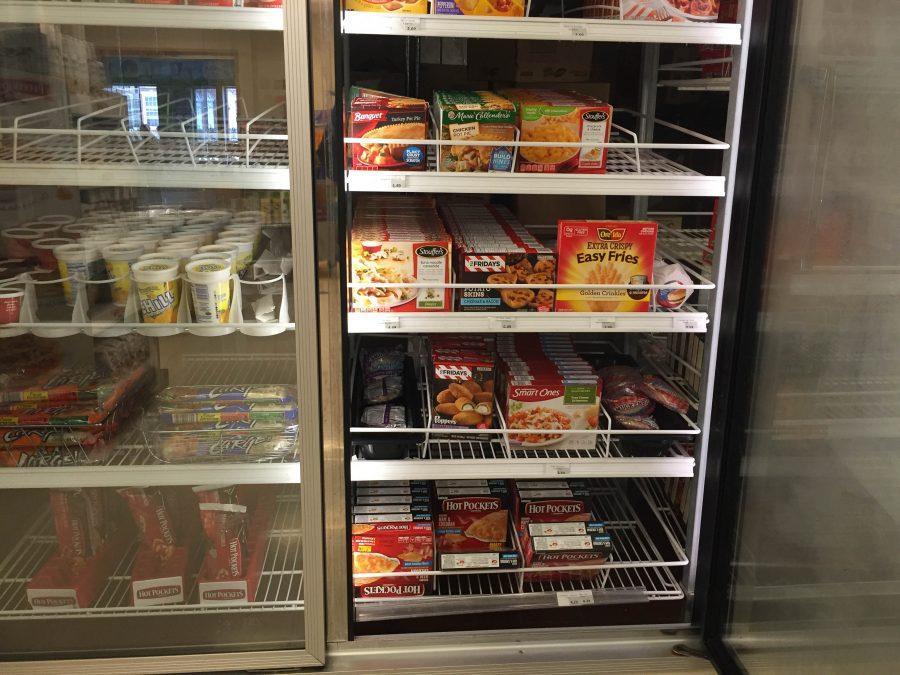Dining service employees talk frozen foods
Frozen food shelved in Ikenberry’s 57 North. March 6 is National Frozen Food Day, and frozen foods have a long history on campus.
March 6, 2017
Thanks to former president Ronald Reagan, the United States observes National Frozen Food Day every year on March 6.
Reagan declared the holiday in 1984 to celebrate the joys and convenience of frozen foods.
Dawn Aubrey, associate director of University Housing for Dining Services, is in charge of the operation of the University’s dining halls. She estimated that frozen food first came to campus in the early 1900s.
Aubrey said some foods used in the dining halls, such as dairy products, fruit, tofu and bread are usually bought fresh, while foods like french fries, fish, shrimp, turkey breast and hamburger patties are usually bought frozen.
She said that at the University, the method of freezing food is a convenient way to ensure the nutrition and overall quality of food in the dining halls.
Get The Daily Illini in your inbox!
“There are some items that are highly perishable, and it is a way to make sure that those items are kept wholesome, kept safe — the quality doesn’t erode,” Aubrey said.
Christopher Henning, senior assistant director of Dining Services at the University, estimated that about 20 percent of the food used by the dining halls is frozen. Henning said there are certain foods that are impossible to buy fresh because of their perishability.
“There’s certain items like bacon. I mean when you’re buying it in amounts that we buy it in, it has to be frozen,” Henning said.
However, Henning also said dining halls are unable to store very large quantities frozen food, so fresh food is used often.
“Thawing product takes time … it can be like three days in a cooler, and we really don’t have the space to take up with doing that,” Henning said.
Both Aubrey and Henning said that over the past 10 years, the amount of frozen food used in the dining halls at the University has been reduced significantly.
“Frankly put, I would say it’s been more than cut in half,” Aubrey said.
Henning said part of the reason for the decrease in frozen food used in the dining halls is that a large portion of the food used is now delivered directly to the dining halls rather than stored in a warehouse.
“We no longer operate a warehouse … Having warehouse items for all the residence units and then transport it, keeping things that were canned or frozen was the best way to really accomplish that,” said Henning, “We now have direct delivery with a number of our vendors.”
Kelly Boeger is the menu management dietitian for University Housing Dining Services. She wrote in an email that although she prefers some specific foods —such as fruit — fresh, sometimes freezing the food makes it a healthier option.
“Vegetables can actually retain more nutritional value because they are frozen shortly after harvest, which ‘locks in’ the nutrients. Nutrients in fresh fruits and vegetables degrade as soon as the food is picked,” Boeger wrote.
One thing Boeger wrote to be aware of when using frozen foods, however, is the additives that may be used to enhance the flavor and shelf-life.
“One downside is that frozen foods often require added sodium as a preservative,” Boeger wrote. “Some foods are also fried before freezing or have added sauces like cheese and butter, which adds extra calories and fat.”
Despite this, she wrote that a common misconception about frozen food is it is not as healthy as fresh food.
“People might perceive fresh food to be more nutritious, but that’s not always the case. Frozen food can be just as nutritious or even more nutritious than fresh, depending on the food,” Boeger wrote.







